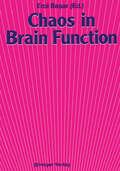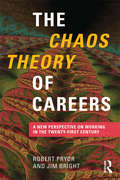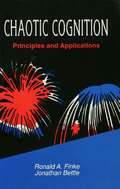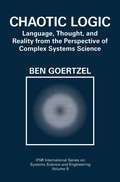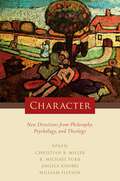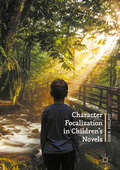- Table View
- List View
Chaos and Nonlinear Psychology: Keys to Creativity in Mind and Life
by Ruth Richards David Schuldberg Shan GuisingerThe pandemic, and our response to it, have shown how unpredictable, irrational, illogical, suddenly changing, and muddled human interactions can be in a time of crisis. How can we make sense of such confusing and baffling behavior? This book reveals how chaos and nonlinear dynamics can bring new understanding to everyday topics in social sciences. It brings together chapters from leaders at the intersection of psychology and chaos and complexity theories. Conceptual and user-friendly, it is built around six themes: 1) Seeing nonlinearity, 2) Finding patterns, 3) using Simple models, 4) Intervening nonlinearly, and 6) teaching a new Worldview. It takes no specialized study-although there is more sophisticated material and optional math for those wishing it. The techie will, in addition, find concepts and diagrams to ponder. The volume is engaging, at times startling-whether about the weather, Internet, organizations, family dynamics, health, evolution, or falling in love. It reveals how many social, personal, clinical, research, and life phenomena become understandable and can be modelled in the light of Nonlinear Dynamical Systems (NDS) theory. It even offers a broadening worldview, happening already in other sciences, toward a more dynamic, interconnected, and evolving picture, including process-oriented appreciation of one's own experience. The book offers those in the field of psychology and the social sciences a stunning new perspective on human behaviour.
Chaos and Nonlinear Psychology: Keys to Creativity in Mind and Life
by David Schuldberg Ruth Richards Shan GuisingerThe pandemic, and our response to it, have shown how unpredictable, irrational, illogical, suddenly changing, and muddled human interactions can be in a time of crisis. How can we make sense of such confusing and baffling behavior? This book reveals how chaos and nonlinear dynamics can bring new understanding to everyday topics in social sciences. It brings together chapters from leaders at the intersection of psychology and chaos and complexity theories. Conceptual and user-friendly, it is built around six themes: 1) Seeing nonlinearity, 2) Finding patterns, 3) using Simple models, 4) Intervening nonlinearly, and 6) teaching a new Worldview. It takes no specialized study-although there is more sophisticated material and optional math for those wishing it. The techie will, in addition, find concepts and diagrams to ponder. The volume is engaging, at times startling-whether about the weather, Internet, organizations, family dynamics, health, evolution, or falling in love. It reveals how many social, personal, clinical, research, and life phenomena become understandable and can be modelled in the light of Nonlinear Dynamical Systems (NDS) theory. It even offers a broadening worldview, happening already in other sciences, toward a more dynamic, interconnected, and evolving picture, including process-oriented appreciation of one's own experience. The book offers those in the field of psychology and the social sciences a stunning new perspective on human behaviour.
Chaos and Order in the World of the Psyche (Psychology Revivals)
by Joanne Wieland-Burston‘I don’t know what’s the matter with me – everything’s upside down; the whole world seems chaotic’ Chaos may erupt in our lives in many different ways – through death, divorce, conflict with family, friends or colleagues. It is a frightening and negative experience, destabilizing the individual and provoking feelings of insecurity. Originally published in English in 1992, the author, through her work as a Jungian analyst, frequently acted as a companion, support and guide to those whose lives were in chaotic turmoil. She describes how therapy helps people to meet chaos, to accept and see it in a different way – as a starting point for a new kind of order in their lives. This ‘organic’ order is better suited to their own personal needs and personality and provides the strong and flexible basis necessary to meet the chaos that belongs to life. Drawing upon the myths, tales and rites of ancient cultures, upon modern chaos theory, and upon her experience as an analyst the author shows the way through the chaos to a fuller, happier and more satisfying life.
Chaos and Order in the World of the Psyche (Psychology Revivals)
by Joanne Wieland-Burston‘I don’t know what’s the matter with me – everything’s upside down; the whole world seems chaotic’ Chaos may erupt in our lives in many different ways – through death, divorce, conflict with family, friends or colleagues. It is a frightening and negative experience, destabilizing the individual and provoking feelings of insecurity. Originally published in English in 1992, the author, through her work as a Jungian analyst, frequently acted as a companion, support and guide to those whose lives were in chaotic turmoil. She describes how therapy helps people to meet chaos, to accept and see it in a different way – as a starting point for a new kind of order in their lives. This ‘organic’ order is better suited to their own personal needs and personality and provides the strong and flexible basis necessary to meet the chaos that belongs to life. Drawing upon the myths, tales and rites of ancient cultures, upon modern chaos theory, and upon her experience as an analyst the author shows the way through the chaos to a fuller, happier and more satisfying life.
Chaos, Catastrophe, and Human Affairs: Applications of Nonlinear Dynamics To Work, Organizations, and Social Evolution
by Stephen J. GuastelloWhether talking about steering a wheelbarrow over rugged terrain or plotting the course of international relations, human performance systems involve change. Sometimes changes are subtle or evolutionary, sometimes they are catastrophic or revolutionary, and sometimes the changes are from periods of relative calm to periods of vibrant oscillations to periods of chaos. As a general rule, more complex systems are likely to produce more complex forms of change. Although social scientists have long acknowledged that change occurs and have considered ways to effect desirable change, the dynamical processes of change have been poorly understood in the past. This volume combines recent advances in mathematics and experimental design with the best available social science theories to produce a new, integrated, and compact theory of work, organizations, and social evolution. The domains of application extend from human decision-making processes to personnel selection and work motivation, work performance under conditions of stress, accident and health risk analysis, the development of social institutions and economic systems, creativity and innovation, organizational development and group dynamics, and political revolutions and war. Relative to other literature on nonlinear dynamical systems theory (NDS), this book is unique in that it integrates new developments in NDS with substantive psychological theory. It builds on many recent developments in organizational theory to show that nonlinear dynamics were often implicit in those works all along. The result is an entirely new way of viewing social events, understanding change processes, and asking questions about social systems. This book also contains much new empirical work and explains the newly developed methods for testing these new hypotheses.
Chaos, Catastrophe, and Human Affairs: Applications of Nonlinear Dynamics To Work, Organizations, and Social Evolution
by Stephen J. GuastelloWhether talking about steering a wheelbarrow over rugged terrain or plotting the course of international relations, human performance systems involve change. Sometimes changes are subtle or evolutionary, sometimes they are catastrophic or revolutionary, and sometimes the changes are from periods of relative calm to periods of vibrant oscillations to periods of chaos. As a general rule, more complex systems are likely to produce more complex forms of change. Although social scientists have long acknowledged that change occurs and have considered ways to effect desirable change, the dynamical processes of change have been poorly understood in the past. This volume combines recent advances in mathematics and experimental design with the best available social science theories to produce a new, integrated, and compact theory of work, organizations, and social evolution. The domains of application extend from human decision-making processes to personnel selection and work motivation, work performance under conditions of stress, accident and health risk analysis, the development of social institutions and economic systems, creativity and innovation, organizational development and group dynamics, and political revolutions and war. Relative to other literature on nonlinear dynamical systems theory (NDS), this book is unique in that it integrates new developments in NDS with substantive psychological theory. It builds on many recent developments in organizational theory to show that nonlinear dynamics were often implicit in those works all along. The result is an entirely new way of viewing social events, understanding change processes, and asking questions about social systems. This book also contains much new empirical work and explains the newly developed methods for testing these new hypotheses.
Chaos in Brain Function: Containing Original Chapters by E. Basar and T. H. Bullock and Topical Articles Reprinted from the Springer Series in Brain Dynamics
by Erol Ba 351 ArThe analysis of deterministic chaos is currently an active field in many branches of research. Mathematically all nonlinear dynamical systems with more than two degrees of freedom can generate chaos, becoming unpredictable over a longer time scale. The brain is a nonlinear system par excellence. Accordingly, the concepts of chaotic dynamics have found, in the last five years, an important application in research on compound electrical activity of the brain. The present volume seeks to cover most of the relevant studies in the newly emerging field of chaotic attractors in the brain. This volume is essentially a selection and reorganization of contri butions from the first two volumes in the Springer Series in Brain Dynamics, which were based on conferences held in 1985 and 1987 in Berlin. It also includes (a) a survey of progress in the recording of evoked oscillations of the brain both at the cellular and EEG levels and (b) an agenda for research on chaotic dynamics. Although the first publications pointing out evidence of chaotic behavior of the EEG did not appear until the beginning of 1985, the presence of the pioneering scientists in this field gave the participants at the first conference (volume 1) a strong impulse toward this field. For me, as conference organizer, having been for a long time active in nonlinear EEG research, the integration of this topic was self-evident; however, the enthusiasm of the conference participants was greater than expected.
Chaos theory in Psychology and the Life Sciences
by Robin Robertson Allan CombsThis book represents the best of the first three years of the Society for Chaos Theory in Psychology conferences. While chaos theory has been a topic of considerable interest in the physical and biological sciences, its applications in psychology and related fields have been obscured until recently by its complexity. Nevertheless, a small but rapidly growing community of psychologists, neurobiologists, sociologists, mathematicians, and philosophers have been coming together to discuss its implications and explore its research possibilities. Chaos theory has been termed the first authentic paradigm shift since the advent of quantum physics. Whether this is true or not, it unquestionably bears profound implications for many fields of thought. These include the cognitive analysis of the mind, the nature of personality, the dynamics of psychotherapy and counseling, understanding brain events and behavioral records, the dynamics of social organization, and the psychology of prediction. To each of these topics, chaos theory brings the perspective of dynamic self-organizing processes of exquisite complexity. Behavior, the nervous system, and social processes exhibit many of the classical characteristics of chaotic systems -- they are deterministic and globally predictable and yet do not submit to precise predictability. This volume is the first to explore ideas from chaos theory in a broad, psychological perspective. Its introduction, by the prominent neuroscientist Walter Freeman, sets the tone for diverse discussions of the role of chaos theory in behavioral research, the study of personality, psychotherapy and counseling, mathematical cognitive psychology, social organization, systems philosophy, and the understanding of the brain.
Chaos theory in Psychology and the Life Sciences
by Robin Robertson Allan CombsThis book represents the best of the first three years of the Society for Chaos Theory in Psychology conferences. While chaos theory has been a topic of considerable interest in the physical and biological sciences, its applications in psychology and related fields have been obscured until recently by its complexity. Nevertheless, a small but rapidly growing community of psychologists, neurobiologists, sociologists, mathematicians, and philosophers have been coming together to discuss its implications and explore its research possibilities. Chaos theory has been termed the first authentic paradigm shift since the advent of quantum physics. Whether this is true or not, it unquestionably bears profound implications for many fields of thought. These include the cognitive analysis of the mind, the nature of personality, the dynamics of psychotherapy and counseling, understanding brain events and behavioral records, the dynamics of social organization, and the psychology of prediction. To each of these topics, chaos theory brings the perspective of dynamic self-organizing processes of exquisite complexity. Behavior, the nervous system, and social processes exhibit many of the classical characteristics of chaotic systems -- they are deterministic and globally predictable and yet do not submit to precise predictability. This volume is the first to explore ideas from chaos theory in a broad, psychological perspective. Its introduction, by the prominent neuroscientist Walter Freeman, sets the tone for diverse discussions of the role of chaos theory in behavioral research, the study of personality, psychotherapy and counseling, mathematical cognitive psychology, social organization, systems philosophy, and the understanding of the brain.
The Chaos Theory of Careers: A New Perspective on Working in the Twenty-First Century
by Robert Pryor Jim BrightThe Chaos Theory of Careers outlines the application of chaos theory to the field of career development. It draws together and extends the work that the authors have been doing over the last 8 to 10 years. This text represents a new perspective on the nature of career development. It emphasizes the dimensions of careers frequently neglected by contemporary accounts of careers such as the challenges and opportunities of uncertainty, the interconnectedness of current life and the potential for information overload, career wisdom as a response to unplanned change, new approaches to vocational assessment based on emergent thinking, the place of spirituality and the search for meaning and purpose in, with and through work, the integration of being and becoming as dimensions of career development. It will be vital reading for all those working in and studying career development, either at advanced undergraduate or postgraduate level and provides a new and refreshing approach to this fast changing subject. Key themes include: Factors such as complexity, change, and contribution People's aspirations in relation to work and personal fulfilment Contemporary realities of career choice, career development and the working world
The Chaos Theory of Careers: A New Perspective on Working in the Twenty-First Century
by Robert Pryor Jim BrightThe Chaos Theory of Careers outlines the application of chaos theory to the field of career development. It draws together and extends the work that the authors have been doing over the last 8 to 10 years. This text represents a new perspective on the nature of career development. It emphasizes the dimensions of careers frequently neglected by contemporary accounts of careers such as the challenges and opportunities of uncertainty, the interconnectedness of current life and the potential for information overload, career wisdom as a response to unplanned change, new approaches to vocational assessment based on emergent thinking, the place of spirituality and the search for meaning and purpose in, with and through work, the integration of being and becoming as dimensions of career development. It will be vital reading for all those working in and studying career development, either at advanced undergraduate or postgraduate level and provides a new and refreshing approach to this fast changing subject. Key themes include: Factors such as complexity, change, and contribution People's aspirations in relation to work and personal fulfilment Contemporary realities of career choice, career development and the working world
Chaotic Cognition Pr: Chaotic Cognition Pr
by Ronald A. Finke Jonathan BettleFocusing on the principles and applications of chaotic thinking, this text seeks to promote a more general understanding and acceptance of this cognitive style. It may help people deal more effectively with chaotic situations, such as economic crises, career changes, and relationship skills.
Chaotic Cognition Pr: Chaotic Cognition Pr
by Ronald A. Finke Jonathan BettleFocusing on the principles and applications of chaotic thinking, this text seeks to promote a more general understanding and acceptance of this cognitive style. It may help people deal more effectively with chaotic situations, such as economic crises, career changes, and relationship skills.
Chaotic Logic: Language, Thought, and Reality from the Perspective of Complex Systems Science (IFSR International Series in Systems Science and Systems Engineering #9)
by Ben GoertzelThis book summarizes a network of interrelated ideas which I have developed, off and on, over the past eight or ten years. The underlying theme is the psychological interplay of order and chaos. Or, to put it another way, the interplay of deduction and induction. I will try to explain the relationship between logical, orderly, conscious, rule-following reason and fluid, self organizing, habit-governed, unconscious, chaos-infused intuition. My previous two books, The Structure of Intelligence and The Evolving Mind, briefly touched on this relationship. But these books were primarily concerned with other matters: SI with constructing a formal language for discussing mentality and its mechanization, and EM with exploring the role of evolution in thought. They danced around the edges of the order/chaos problem, without ever fully entering into it. My goal in writing this book was to go directly to the core of mental process, "where angels fear to tread" -- to tackle all the sticky issues which it is considered prudent to avoid: the nature of consciousness, the relation between mind and reality, the justification of belief systems, the connection between creativity and mental illness,.... All of these issues are dealt with here in a straightforward and unified way, using a combination of concepts from my previous work with ideas from chaos theory and complex systems science.
Chaplains to the Imprisoned: Sharing Life with the Incarcerated
by Richard D ShawChaplains to the Imprisoned begins to fill the information gap through its in-depth study of prison chaplains as seen by co-workers, inmates, and the chaplains themselves. They describe their roles, share difficulties which are encountered in their ministry, and personal methods for coping with these difficulties, especially those which may be internalized as stress. The author, a Roman Catholic priest with a doctorate in criminal justice, provides a fascinating look into the work of chaplains who serve in correctional institutions. This new book sheds a much-needed light on the often hidden, yet significant, role played by chaplains within correctional facilities. Little is known of these chaplains and the work that they do. Though they are frequently depicted in television and film, many of these images are stereotypes from writers’imaginations. In this unique book, chaplains speak for themselves through the results of a survey questionnaire sent by the author to local- and state-level chaplains in New York State and to chaplains throughout the federal prison system. Chaplains to the Imprisoned, the first non-denominational book on these clergy, explores: the history of chaplaincy in this country, including the irony that chaplains have often been treated as unwanted intruders in penitentiaries--which were created originally by religious groups chaplains as seen by other professionals in the field--sometimes positive, often negative, opinions of chaplains drawn from literature written by wardens, corrections officers, and others who deal with chaplains on a routine basis chaplains as seen by inmates--published opinions by inmates who have recorded their impressions of facility chaplains chaplains as seen by chaplains--their own descriptions of their work, frustrations, successes, and failures, along with suggestions for the betterment of the role of chaplainsThis book is an eye-opening look into the world of prison chaplaincy for students of criminal justice and religion, policymakers for prisons and jails, seminary students, and clergy members themselves, as well as individuals interested in what often goes on behind prison walls from a chaplain’s perspective.
Chaplains to the Imprisoned: Sharing Life with the Incarcerated
by Richard D ShawChaplains to the Imprisoned begins to fill the information gap through its in-depth study of prison chaplains as seen by co-workers, inmates, and the chaplains themselves. They describe their roles, share difficulties which are encountered in their ministry, and personal methods for coping with these difficulties, especially those which may be internalized as stress. The author, a Roman Catholic priest with a doctorate in criminal justice, provides a fascinating look into the work of chaplains who serve in correctional institutions. This new book sheds a much-needed light on the often hidden, yet significant, role played by chaplains within correctional facilities. Little is known of these chaplains and the work that they do. Though they are frequently depicted in television and film, many of these images are stereotypes from writers’imaginations. In this unique book, chaplains speak for themselves through the results of a survey questionnaire sent by the author to local- and state-level chaplains in New York State and to chaplains throughout the federal prison system. Chaplains to the Imprisoned, the first non-denominational book on these clergy, explores: the history of chaplaincy in this country, including the irony that chaplains have often been treated as unwanted intruders in penitentiaries--which were created originally by religious groups chaplains as seen by other professionals in the field--sometimes positive, often negative, opinions of chaplains drawn from literature written by wardens, corrections officers, and others who deal with chaplains on a routine basis chaplains as seen by inmates--published opinions by inmates who have recorded their impressions of facility chaplains chaplains as seen by chaplains--their own descriptions of their work, frustrations, successes, and failures, along with suggestions for the betterment of the role of chaplainsThis book is an eye-opening look into the world of prison chaplaincy for students of criminal justice and religion, policymakers for prisons and jails, seminary students, and clergy members themselves, as well as individuals interested in what often goes on behind prison walls from a chaplain’s perspective.
Character: New Directions from Philosophy, Psychology, and Theology
by Christian B. Miller, R. Michael Furr, Angela Knobel, William FleesonThis collection contains some of the best new work being done on the subject of character from the perspectives of philosophy, theology, and psychology. From creating a virtual reality simulation of the Milgram shock experiments to understanding the virtue of modesty in Muslim societies to defending soldiers' moral responsibility for committing war crimes, these 31 chapters break much new ground and significantly advance our understanding of character. The main topics covered fall under the heading of our beliefs about character, the existence and nature of character traits, character and ethical theory, virtue epistemology, the nature of particular virtues, character development, and challenges to character and virtue from neuroscience and situationism. These papers stem from the work of the Character Project (www.thecharacterproject.com) at Wake Forest University, generously supported by the John Templeton Foundation. This collection is truly unique in featuring the work of many young, up-and-coming voices in their fields with new perspectives to offer. Together their work will significantly shape discussions of character for years to come.
Character: New Directions from Philosophy, Psychology, and Theology
This collection contains some of the best new work being done on the subject of character from the perspectives of philosophy, theology, and psychology. From creating a virtual reality simulation of the Milgram shock experiments to understanding the virtue of modesty in Muslim societies to defending soldiers' moral responsibility for committing war crimes, these 31 chapters break much new ground and significantly advance our understanding of character. The main topics covered fall under the heading of our beliefs about character, the existence and nature of character traits, character and ethical theory, virtue epistemology, the nature of particular virtues, character development, and challenges to character and virtue from neuroscience and situationism. These papers stem from the work of the Character Project (www.thecharacterproject.com) at Wake Forest University, generously supported by the John Templeton Foundation. This collection is truly unique in featuring the work of many young, up-and-coming voices in their fields with new perspectives to offer. Together their work will significantly shape discussions of character for years to come.
Character and the Conduct of Life: Practical Psychology for Everyman (Psychology Revivals)
by William McDougallFirst published in 1927, the preface reads: "It is directed to men and women of goodwill who are not completely satisfied with themselves, who believe that by taking thought they may add, however little, to their moral stature and to their efficiency in working towards whatever goals they may have adopted. The book is an essay in practical morals and is not at all concerned with ethical theories." A fascinating glimpse into psychology and morals from the early twentieth century, including chapters for young people, parents and children, husbands and wives!
Character and the Conduct of Life: Practical Psychology for Everyman (Psychology Revivals)
by William McDougallFirst published in 1927, the preface reads: "It is directed to men and women of goodwill who are not completely satisfied with themselves, who believe that by taking thought they may add, however little, to their moral stature and to their efficiency in working towards whatever goals they may have adopted. The book is an essay in practical morals and is not at all concerned with ethical theories." A fascinating glimpse into psychology and morals from the early twentieth century, including chapters for young people, parents and children, husbands and wives!
Character Assassination throughout the Ages
by Martijn Icks Eric ShiraevUsing a variety of cases from history and today's life, the book examines character attackers targeting the private lives, behavior, values, and identity of their victims. Numerous historical examples show that character assassination has always been a very effective weapon to win political battles or settle personal scores.
Character Computing (Human–Computer Interaction Series)
by Alia El Bolock Yomna Abdelrahman Slim AbdennadherThe book gives an introduction into the theory and practice of the transdisciplinary field of Character Computing, introduced by Alia El Bolock. The latest scientific findings indicate that “One size DOES NOT fit all” in terms of how to design interactive systems and predict behavior to tailor the interaction experience. Emotions are one of the essential factors that influence people’s daily experiences; they influence decision making and how different emotions are interpreted by different individuals. For example, some people may perform better under stress and others may break. Building upon Rosalind Picard’s vision, if we want computers to be genuinely intelligent and to interact naturally with us, we must give computers the ability to recognize, understand, even to have and express emotions and how different characters perceive and react to these emotions, hence having richer and truly tailored interaction experiences. Psychological processes or personality traits are embedded in the existing fields of Affective and Personality Computing. However, this book is the first that systematically addresses this including the whole human character; namely our stable personality traits, our variable affective, cognitive and motivational states as well as our morals, beliefs and socio-cultural embedding. The book gives an introduction into the theory and practice of the transdisciplinary field of Character Computing. The emerging field leverages Computer Science and Psychology to extend technology to include the whole character of humans and thus paves the way for researchers to truly place humans at the center of any technological development. Character Computing is presented from three main perspectives: ● Profiling and sensing the character ● Leveraging characters to build ubiquitous character-aware systems ● Investigating how to extend Artificial Intelligence to create artificial characters
Character Focalization in Children’s Novels
by Don K. PhilpotThis book offers a comprehensive analysis of character focalization in ten contemporary realistic children’s novels. The author argues that character focalization, defined as the location of fictional world perception in the mind of a character, is a prominent textual structure in these novels. He demonstrates how significant meanings are conveyed in a variety of forms related to characters’ personal and interpersonal experiences. Through close analysis of each text, moreover, he exposes distinctive perceptual, psychological, and social-psychological patterns in the opening chapters of each novel, which are thereafter developed by the principles of continuation, augmentation, and reconfiguration. This book will appeal to scholars, teachers, and students in the fields of narrative studies, stylistics, children’s literature scholarship, linguistics, and education.
The Character Gap: How Good Are We? (Philosophy in Action)
by Christian MillerWe like to think of ourselves, our friends, and our families as decent people. We may not be saints, but we are still honest, relatively kind, and mostly trustworthy. Miller argues here that we are badly mistaken in thinking this. Hundreds of recent studies in psychology tell a different story: that we all have serious character flaws that prevent us from being as good as we think we are - and that we do not even recognize that these flaws exist. But neither are most of us cruel or dishonest. Instead, Miller argues, we are a mixed bag. On the one hand, most of us in a group of bystanders will do nothing as someone cries out for help in an emergency. Yet it is also true that there will be many times when we will selflessly come to the aid of a complete stranger - and resist the urge to lie, cheat, or steal even if we could get away with it. Much depends on cues in our social environment. Miller uses this recent psychological literature to explain what the notion of "character" really means today, and how we can use this new understanding to develop a character better in sync with the kind of people we want to be.
The Character Gap: How Good Are We? (Philosophy In Action)
by Christian MillerWe like to think of ourselves, our friends, and our families as decent people. We may not be saints, but we are still honest, relatively kind, and mostly trustworthy. Miller argues here that we are badly mistaken in thinking this. Hundreds of recent studies in psychology tell a different story: that we all have serious character flaws that prevent us from being as good as we think we are - and that we do not even recognize that these flaws exist. But neither are most of us cruel or dishonest. Instead, Miller argues, we are a mixed bag. On the one hand, most of us in a group of bystanders will do nothing as someone cries out for help in an emergency. Yet it is also true that there will be many times when we will selflessly come to the aid of a complete stranger - and resist the urge to lie, cheat, or steal even if we could get away with it. Much depends on cues in our social environment. Miller uses this recent psychological literature to explain what the notion of "character" really means today, and how we can use this new understanding to develop a character better in sync with the kind of people we want to be.



